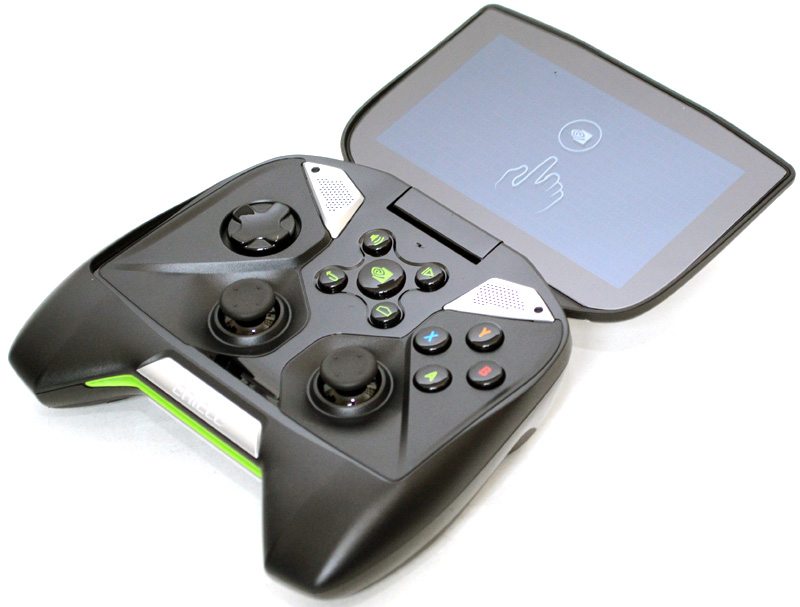Nvidia Shield Portable Games Console Review
A Closer Look
The console is really unique looking, it’s quite bulky and heavy to hold, but feels every bit the premium product from the moment you lay your hands on it. The top panel to the clam shell design features silver plastic cover that can be removed and customised, Nvidia even sell extra ones to help you easily customise the appearance of the console.

Fortunate that the top cover can be easily removed and replaced, since the brand new one I opened is scuffed! See the left and right edges of the picture… oh my, best keep an eye on QC Nvidia!

Around the back you’ll find two top back buttons, LB and RB, as well as two full analogue triggers, LT and RT. In the middle is where all the really exciting stuff is happening, with a large ventilation area for the system fan to exhaust, much like you would find on the side of a laptop. The main IO section consists of a micro SD card slot, which I’m told can handle up to a 128GB card, a mini HDMI port (cable sold separately), micro USB input which supports USB OTG and a 3.5mm 4-pole compatible headset port.

There is a deep ergonomic curve to the base, allow you to really get a grip of this thing and the soft touch finish means it’s both comfortable and grippy, so little chance of it slipping through your fingers while gaming.

The top panel pulls open on a very firm feeling hinge, I really like that the screen doubles as the protective cover for the whole console, saving the need for a dedicated protective shell.

The screen locks really firm at any angle, but can be folded back a full 180-degrees, so you should have no issues finding an optimal viewing position.

The screen comes with a temporary protective plastic sheet on it, behind which you’ll find a gorgeous 5-inch, 1280 x 720 p retinal multi-touch display that packs in 294 dpi.

The console is packed full of control features, aside from the obvious touch screen, you’ll find two joysticks, a D-pad, ABXY buttons, L/R bumpers, L/R analog triggers, Start/Back/Home/Volume buttons, and a multi-function Shield button, motion sensors; including a 6-axis gyros plus accelerometer.

The quality of the analogue sticks and D-PAD pad is awesome, similar in feel to that of the Xbox 360 controller, but with better quality sticks and a much better D pad.

Sound is handled by a pair of stereo speakers which have bass reflex and Nvidia promise they’ll deliver some impressive sound quality.

Tucked away near the back is a pinhole microphone, perfect for Google Now, chatting on Skype or voice commands in any other applications.

Hut the Shield button in the middle and the device powers up, so let’s get right to it and see what this thing can do!










Not having the slightest interest in mobile gaming I would normally ignore reviews on them and the devices but I read this one and found it very interesting (not that it changes my stance one iota). Thank you.
I like how nVidia has modelled it on a console controller and it makes sense to do it that way because to my way of thinking kids play on consoles and are accustomed to the controller so adjusting to this will be a non issue and this device is no doubt targeted at youngsters which is a huge market and the price is quite palatable so mom & pop shouldn’t have a too hard a time coughing up. If I were a kid I’d much rather have something like this than a PSP.
As for me, a dyed-in-the-wool PC gamer a controller is something I just can’t get used to, it is nothing but a frustration even for driving games (a Logitech G27 is more like it). If I can’t control the game properly with a keyboard and mouse I’ll toss it aside in a heartbeat.
It’s an interesting idea.
I like it a lot and if i had the cash to spare, i would get one.
My only issue with it how long would you use it before the initial novelty wore off?
Once that’s gone, you’ve got yourself yet another android device.
Though i do like the idea of being able to play Dark Souls 2 and War Thunder from the comfort of my bed.
or even Nidhogg